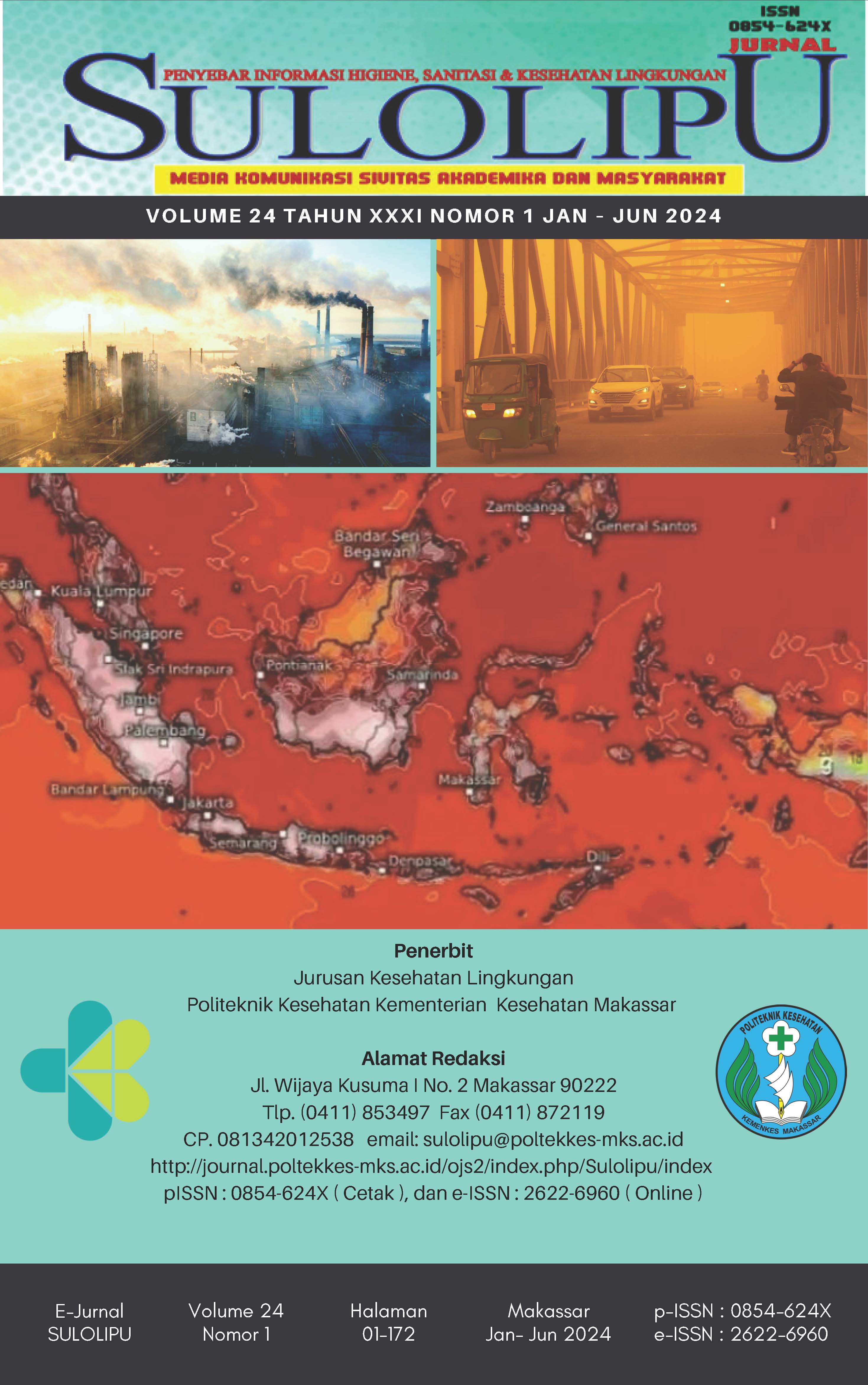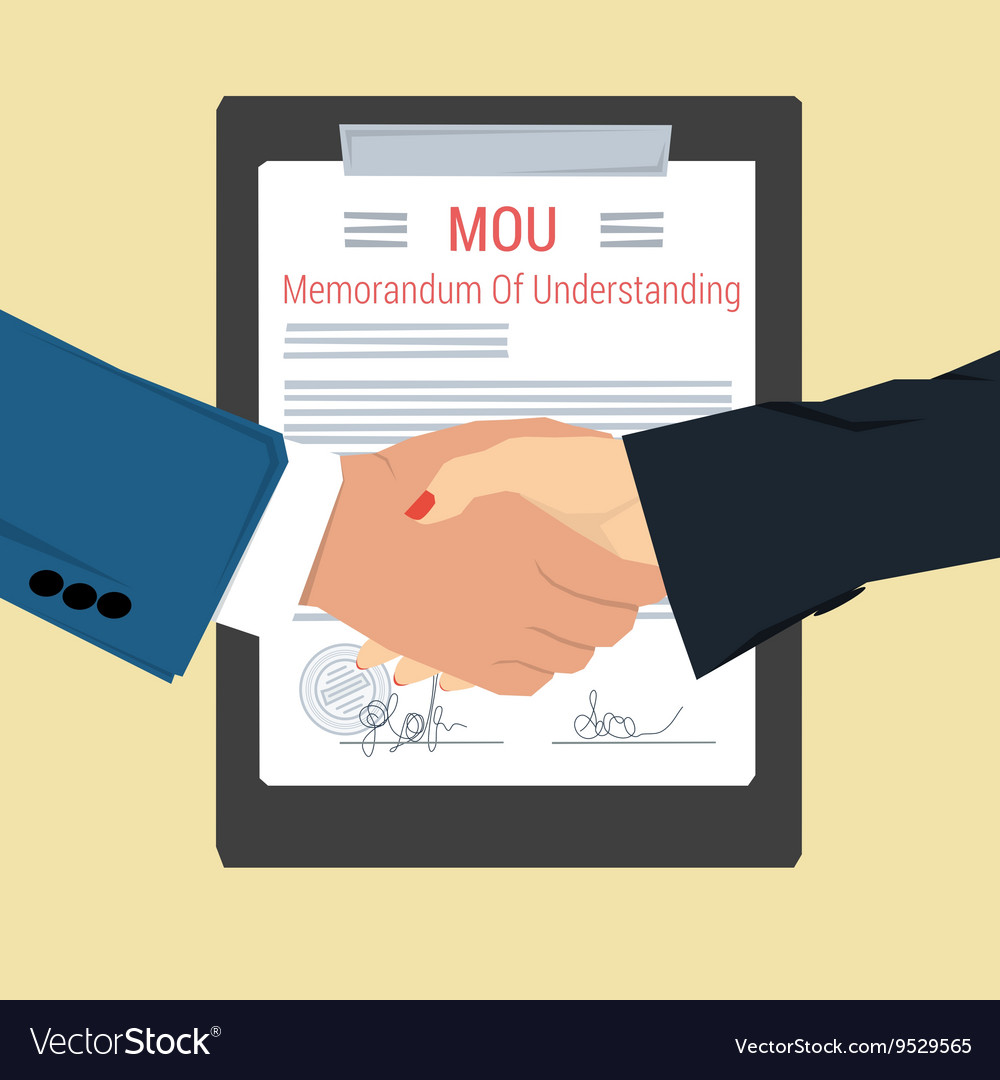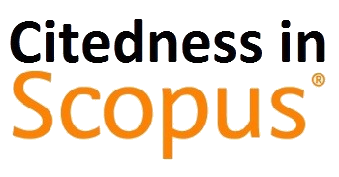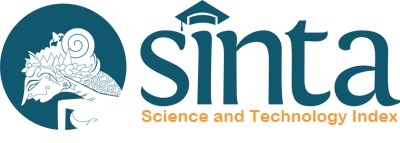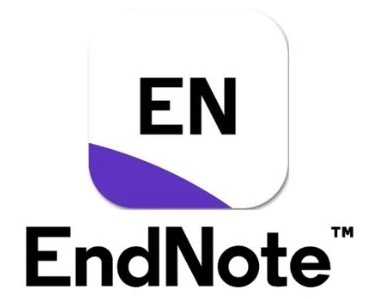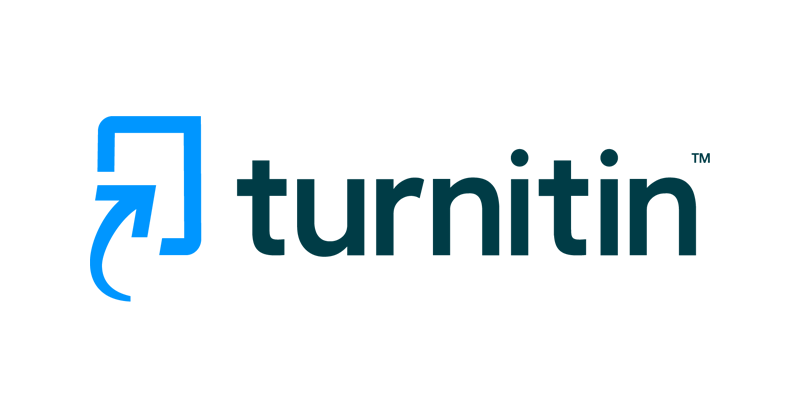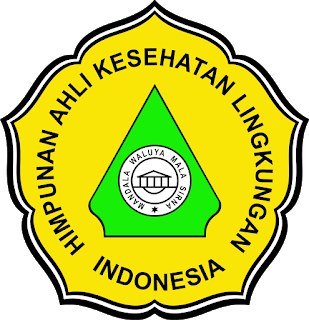Water Quality of Pampang River around Pampang Harapan Landfill in Kayong Utara Regency, West Kalimantan
DOI:
https://doi.org/10.32382/sulo.v24i1.298Keywords:
Kualitas air, Sungai Pampang, STORETAbstract
Pollution in the Pampang River is caused by sand mining and residential domestic waste. The potential for pollution can reduce environmental quality and public health if there is no proper management. Testing for dissolved solids (DSS), pH, chemical oxygen demand (COD), biological oxygen demand (BOD), dissolved oxygen (DO), oil and fat, total coliform bacteria (TCF), and fecal coliform bacteria (FCF) is the goal of this study. January and April 2022 were the months in which the study was conducted. This study used a descriptive and analytical approach, drawing from both primary and secondary sources, and analyzing the results using the STORET technique. Generally speaking, the Pampang River's water state in January 2022 satisfies river water quality criteria. Several measures measuring the quality of river water were found to be over the norms in April 2022. These measurements included COD, BOD, and DO. Class I water quality is moderately contaminated at upstream point A1, according to the study's findings, whereas intermediate and downstream areas A2 and A3 are mildly polluted. Sites A1, A2, and A3 in Class III are somewhat contaminated. Class IV sites A1, A2, and A3 are clean, however. Locations A2 and A3, which are closer to the landfill, often have superior river water quality than A1. This shows that the source of Pampang River water pollution does not only come from the Pampang Harapan landfill, but also comes from community activities such as sand mining and domestic waste from settlements around the river.
Keywords : Pampang river; STORET; water quality
References
Arbie, R. R., Nugraha, W. D., & Sudarno. (2015). Studi Kemampuan Self Purification pada Sungai Progo di tinjau dari parameterorganik DO dan BOD Kecamatan Sentolo Kabupaten Kulon Progo Provinsi D.I. Yogyakarta. Jurnal Tehnik Lingkungan, 4(1), 1–15.
Arsyad, Rukmana, D., Salman, D., & Alimuddin, I. (2020). Impact of sand mining on the changes of morphological and physical dynamics in Sa’dang River, Pinrang District, Indonesia. J. Degrade. Min. Land Manage, 8(1), 2451–2460. https://doi.org/10.15243/jdmlm.2020.081.2451
Arum, S. P. I., Harisuseno, D., & Soemarno, S. (2019). Domestic wastewater contribution to water quality of Brantas River at Dinoyo Urban Village, Malang City. Jurnal Pembangunan Dan Alam Lestari, 10(2), 84–91. https://doi.org/https://doi.org/10.21776/ub.jpal.2019.010.02.02
Baird, R. B., Eaton, A. D., & Rice, E. W. (2017). Standard Methods for the Examinations of Water and Wastewater 23rd edition. In Standard Methods for the Examination of Water and Wastewater. American Public Health Association.
Bayram, A., Uzlu, E., Kankal, M., & Dede, T. (2014). Modeling stream dissolved oxygen concentration using teaching–learning based optimization algorithm. Environmental Earth Sciences, 73, 6565–6576.
Bozorg-Haddad, O., Delpasand, M., & Loáiciga, H. A. (2021). 10 - Water quality, hygiene, and health. In Economical, Political, and Social Issues in Water Resources (pp. 217–257). Elsevier. https://doi.org/https://doi.org/10.1016/B978-0-323-90567-1.00008-5
Chavan, D., Arya, S., & Kumar, S. (2022). Open dumping of organic waste: Associated fire, environmental pollution and health hazards. Advanced Organic Waste Management: Sustainable Practices and Approaches, 15–31. https://doi.org/10.1016/B978-0-323-85792-5.00014-9
Cristaldi, A., Oliveri, G., Hea, E., & Zuccarello, P. (2017). Environmental Technology & Innovation Phytoremediation of contaminated soils by heavy metals and PAHs . A brief review. Environmental Technology & Innovation, 8, 309–326. https://doi.org/10.1016/j.eti.2017.08.002
Dinas, P. U. D. P. R. (2019). Profil Persampahan Kabupaten Kayong Utara. Profil Persampahan Kabupaten Kayong Utara, 1–17.
Haderiah, H., & Wahdaniyah, F. (2018). Kualitas bakteriologis (MPN Coliform) pada sumber mata air di Desa Buntu Ampang Kec. Baroko Kab. Enrekang. Sulolipu: Media Komunikasi Sivitas Akademika Dan Masyarakat, 18(1), 36–41. https://doi.org/10.32382/sulolipu.v18i1.734
Hamdani, A. H., Nurdrajat, Hutabarat, J., & Haryanto, A. D. (2023). The water chemistry quality of the ex-sand mining sites in Gantar District, West Java, for Freshwater Fish cultivation. European Journal of Environment and Earth Science, 4(5), 1–5. https://doi.org/http://dx.doi.org/10.24018/ejgeo.2023.4.5.417
Hendra, Y. (2016). Perbandingan Sistem Pengelolaan Sampah di Indonesia dan Korea Selatan: Kajian 5 Aspek Pengelolaan Sampah. Aspirasi: Jurnal Masalah-Masalah Sosial, 7(1), 77–91.
Iashania, Y., Ganang, N. M. A., Saptawartono, Murati, F., Aqli, Y. K., & Utari, P. (2023). Analisa kualitas air permukaan pada kolam bekas penambangan pasir berdasarkan PP Nomor 22 Baku Mutu Air Kelas III Lampiran VI Tahun 2021. Innovative, 3(6), 6662–6670. https://doi.org/https://doi.org/10.31004/innovative.v3i6.7250
Irhamni, Pandia, S., Purba, E., & Hasan, W. (2017). Kandungan logam berat pada air lindi tempat pembuangan akhir (TPA) sampah Kota Banda Aceh. Seminar Nasional PascaSarjana (SNP) Unsyiah 2017, A19–A22.
Krishnamurthy, N. R., Nagasai, T., Kumar, M. A., Kumar, P. S., & Kumar, N. R. (2023). Comparative study of Conventional and other Filter Medium. IOP Conference Series: Earth and Environmental Science, 1130(1). https://doi.org/10.1088/1755-1315/1130/1/012003
Marta, Y. M. V., & Afdal, A. (2019). Karakteristik Lindi Dan Air Permukaan Di Tempat Pembuangan Akhir Sampah Sungai Andok Kota Padang Panjang. Jurnal Ilmu Fisika | Universitas Andalas, 11(1), 1–8. https://doi.org/10.25077/jif.11.1.1-7.2019
Patel, A. K., Singhania, R. R., Pandey, A., Joshi, V. K., Nigam, P. S., & Soccol, C. R. (2014). Enterobacteriaceae, Coliforms and E. Coli: Introduction. In Encyclopedia of Food Microbiology: Second Edition (pp. 659–666). Academic Press. https://doi.org/https://doi.org/10.1016/B978-0-12-384730-0.00096-3
Pusat Pendidikan dan Pelatihan Sumber Daya Air dan Konstruksi. (2017). Modul Morfologi Sungai Pelatihan Perencanaan Teknik Sungai. Kementerian PUPR.
Rentier, E. S., & Cammeraat, L. H. (2022). The environmental impacts of river sand mining. Sci. Total Environ., 838, 155877. https://doi.org/10.1016/J.SCITOTENV.2022.155877
Samal, B., Mani, S., & Madguni, O. (2020). Open dumping of waste and its impact on our water resources and health—A case of New Delhi, India. Recent Developments in Waste Management, 127–154. https://doi.org/https://doi.org/10.1007/978-981-15-0990-2_10
Sari, R. N., & Afdal. (2017). Karakteristik air lindi (leachate ) di tempat pembuangan akhir sampah air dingin Kota Padang. Jurnal Fisika Unand, 6(1), 93–99.
Siddiqua, A., Hahladakis, J. N., & Al-Attiya, W. A. K. A. (2022). An overview of the environmental pollution and health effects associated with waste landfilling and open dumping. Environ. Sci. Pollut. Res., 29(39), 58514–58536. https://doi.org/10.1007/s11356-022-21578-z
Umutesi, O., Sajidan, & Masykuri, M. (2018). Groundwater quality and public health of the community around Mojosongo landfill, Surakarta city. International Conference on Science And Applied Science (ICSAS) 2018, 020043-1-020043–020049. https://doi.org/https://doi.org/10.1063/1.5054447
Wijayakusuma, D. M. S., & Satiawan, P. R. (2020). Penentuan Lokasi Alternatif TPA (Tempat Pembuangan Akhir) Sampah di Kabupaten Klungkung. Jurnal Teknik ITS, 8(2), F133–F138.
Zhang, X., Chen, L., & Shen, Z. (2021). Impacts of rapid urbanization on characteristics, sources and variation of fecal coliform at watershed scale. Journal of Environmental Management, 286, 112195. https://doi.org/10.1016/J.JENVMAN.2021.112195
Downloads
Published
How to Cite
Issue
Section
PDF (Bahasa Indonesia) downloaded: 511

